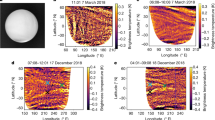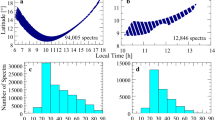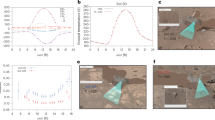Abstract
Venus is completely covered by a thick cloud layer, of which the upper part is composed of sulphuric acid and some unknown aerosols1. The cloud tops are in fast retrograde rotation (super-rotation), but the factors responsible for this super-rotation are unknown2. Here we report observations of Venus with the Venus Monitoring Camera3 on board the Venus Express spacecraft. We investigate both global and small-scale properties of the clouds, their temporal and latitudinal variations, and derive wind velocities. The southern polar region is highly variable and can change dramatically on timescales as short as one day, perhaps arising from the injection of SO2 into the mesosphere. The convective cells in the vicinity of the subsolar point are much smaller than previously inferred4,5,6, which we interpret as indicating that they are confined to the upper cloud layer, contrary to previous conclusions7,8, but consistent with more recent study9.
This is a preview of subscription content, access via your institution
Access options
Subscribe to this journal
Receive 51 print issues and online access
$199.00 per year
only $3.90 per issue
Buy this article
- Purchase on Springer Link
- Instant access to full article PDF
Prices may be subject to local taxes which are calculated during checkout





Similar content being viewed by others
References
Esposito, L. W. et al. in Venus (eds Hunten, D. M., Colin, L., Donahue, T. M. & Moroz, V. I.) 484–564 (Univ. Arizona Press, Tucson, 1983)
Limaye, S. S. Venus atmospheric circulation: known and unknown. J. Geophys. Res. 112 E04S09 doi: 10.1029/2006JE002814 (2007)
Markiewicz, W. J. et al. Venus monitoring camera for Venus Express. Planet. Space Sci. 55, 1701–1711 (2007)
Murray, B. C. et al. Venus: Atmospheric motion and structure from Mariner 10 pictures. Science 183, 1307–1315 (1974)
Rossow, W. B. et al. Cloud morphology and motions from Pioneer Venus images. J. Geophys. Res. 85, 8107–8128 (1980)
Covey, C. C. & Schubert, G. Mesoscale convection in the clouds of Venus. Nature 290, 17–20 (1981)
Baker, R. D. & Schubert, G. Cellular convection in the atmosphere of Venus. Nature 355, 710–712 (1992)
Belton, M. J. S. et al. Cloud patterns, waves, and convection in the Venus atmosphere. J. Atmos. Sci. 33, 1394–1417 (1976)
Baker, R. D., Schubert, G. & Jones, P. W. High Rayleigh number compressible convection in Venus’ atmosphere: Penetration, entrainment and turbulence. J. Geophys. Res. 104, 3815–3832 (1999)
Taylor, F. W. et al. Structure and meteorology of the middle atmosphere of Venus: infrared remote sensing from the Pioneer Orbiter. J. Geophys. Res. 85, 7963–8006 (1980)
Rossow, W. B., Del Genio, A. D. & Eichler, T. Cloud tracked winds from Pioneer Venus OCPP images. J. Atmos. Sci. 47, 2053–2084 (1990)
Belton, M. J. S. et al. Images from Galileo of the Venus cloud deck. Science 253, 1531–1536 (1991)
Toigo, A., Gierasch, P. J. & Smith, M. D. High resolution cloud feature tracking on Venus by Galileo. Icarus 109, 318–336 (1994)
Newman, M. G., Schubert, G., Kliore, A. J. & Patel, I. R. Zonal winds in the middle atmosphere of Venus from Pioneer Venus radio occultation data. J. Atmos. Sci. 41, 1901–1913 (1984)
Baker, R. D., Schubert, G. & Jones, P. W. Cloud-level penetrative compressible convection in the Venus atmosphere. J. Atmos. Sci. 55, 3–18 (1998)
Sato, M., Travis, L. D. & Kawabata, K. Photopolarimetry analysis of the Venus atmosphere in the polar regions. Icarus 124, 596–585 (1996)
Zasova, L. V. Ignatiev, N. Khatuntsev, I. & Linkin, V. Structure of the Venus atmosphere. Planet. Space Sci. 55, 1712–1728 (2007)
Acknowledgements
S.S.L. was supported by a NASA grant.
Author information
Authors and Affiliations
Corresponding author
Rights and permissions
About this article
Cite this article
Markiewicz, W., Titov, D., Limaye, S. et al. Morphology and dynamics of the upper cloud layer of Venus. Nature 450, 633–636 (2007). https://doi.org/10.1038/nature06320
Received:
Accepted:
Published:
Issue Date:
DOI: https://doi.org/10.1038/nature06320
This article is cited by
-
Generation of gravity waves from thermal tides in the Venus atmosphere
Nature Communications (2021)
-
BepiColombo Science Investigations During Cruise and Flybys at the Earth, Venus and Mercury
Space Science Reviews (2021)
-
Venus Atmospheric Thermal Structure and Radiative Balance
Space Science Reviews (2018)
-
Ultraviolet imager on Venus orbiter Akatsuki and its initial results
Earth, Planets and Space (2018)
-
The Atmospheric Dynamics of Venus
Space Science Reviews (2017)
Comments
By submitting a comment you agree to abide by our Terms and Community Guidelines. If you find something abusive or that does not comply with our terms or guidelines please flag it as inappropriate.



